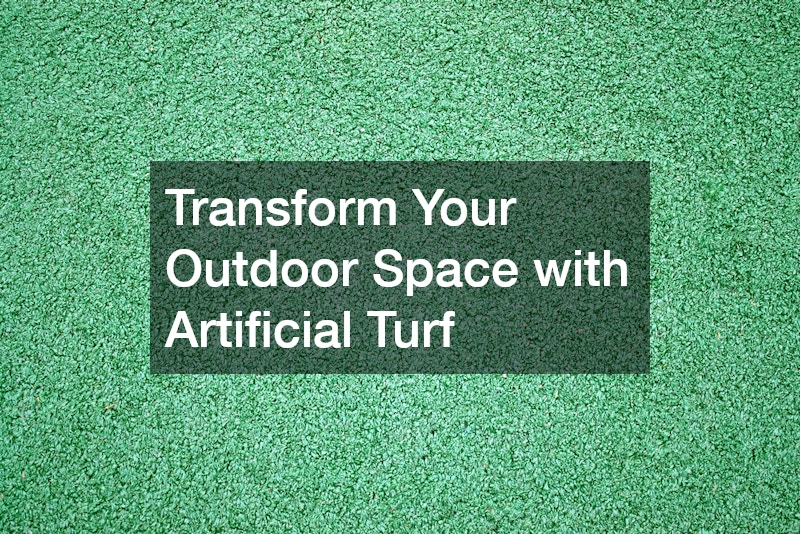A beautiful, well-kept outdoor space can greatly enhance any property, but maintaining natural grass often demands significant time and effort. Enter artificial turf—a transformative solution that combines aesthetic appeal with practical benefits. Over the years, it has evolved to offer a realistic, lush appearance without the need for constant mowing, watering, or fertilizing.
This article explores how this modern lawn option can elevate your outdoor space, covering its benefits, comparisons with natural grass, installation process, and maintenance tips.
What are the Benefits of Using Artificial Turf?
Low Maintenance Requirements
One of the primary advantages of artificial turf is its minimal maintenance. Unlike natural grass, it doesn’t require regular mowing, fertilizing, or pesticides, significantly reducing the time and effort needed for upkeep.
Water Conservation
This type of lawn is environmentally friendly because it eliminates the need for frequent watering, which is often required to keep natural grass healthy, especially in hot or dry climates. Reducing irrigation not only conserves water but also lowers utility costs, making it a practical and sustainable option for homeowners in regions with water restrictions.
Durability and Longevity
Durability is another key benefit. High-quality turf can withstand heavy foot traffic, harsh weather, and pets without losing shape or color. Unlike natural grass, it doesn’t develop bald patches or muddy areas, keeping your outdoor space attractive and functional for years.
Consistent Aesthetic Appeal
Consistency in appearance is a major advantage. It stays lush and green year-round, providing a visually appealing outdoor space. Homeowners no longer need to worry about brown spots, weeds, or uneven growth—resulting in a flawless, vibrant lawn throughout the seasons.
How Does Artificial Turf Compare to Natural Grass?
Cost Efficiency
While the initial installation can be higher than laying natural grass, it often proves cost-effective in the long run. Natural lawns require ongoing expenses for water, fertilizers, and lawn care equipment, whereas this type of lawn reduces recurring maintenance costs, making it a financially sensible option over time.
Environmental Impact
This type of lawn can be an eco-conscious choice, helping conserve water and reduce chemical use. Choosing high-quality, recyclable materials minimizes environmental impact. While natural grass has some ecological benefits, its sustainability—especially in water-scarce regions—makes it an appealing alternative.
Usability in Various Climates
This type of lawn performs well across diverse climates, from arid deserts to temperate regions. It eliminates concerns about grass dying during droughts or becoming waterlogged after heavy rains, ensuring your outdoor space remains functional and visually appealing year-round.
What is the Installation Process for Artificial Turf?
Site Preparation and Planning
Proper installation begins with thorough site preparation. This involves clearing existing vegetation, removing debris, and ensuring a level surface. Accurate planning at this stage sets the foundation for a smooth installation process and long-lasting results.
Base Construction
A stable base is essential for performance. Typically, this involves laying a layer of crushed stone or gravel to provide drainage and prevent settling. The base should be compacted and leveled to create a firm, even foundation for the lawn.
Laying the Turf
Once the base is prepared, the turf is rolled out and positioned carefully. Seams are aligned, and excess material is trimmed to fit the area precisely. Proper installation at this stage ensures a natural look and prevents uneven surfaces.
Securing and Finishing Touches
After placement, the turf is anchored using stakes or adhesive, and infill materials like sand or rubber granules are added to enhance stability and realism. The final touches, including brushing and edging, help the turf achieve a polished, lifelike finish.
How Do I Maintain My Artificial Turf?
Regular Cleaning Tips
Maintaining artificial turf is straightforward. Regularly remove leaves, dirt, and debris using a leaf blower, broom, or hose. This simple routine keeps the surface clean and attractive without extensive effort.
Preventing and Addressing Wear and Tear
High-traffic areas may experience minor matting or flattening. Brushing the turf periodically helps maintain upright fibers and prevents uneven spots. For areas prone to heavy use, consider additional infill or reinforcement to prolong lifespan.
Dealing with Stains and Spills
Accidents happen, but this type of lawn handles spills well. Rinse liquids promptly and use mild soap or a recommended cleaner for stubborn stains. Avoid harsh chemicals that could damage the fibers.
Seasonal Care Considerations
Although largely unaffected by seasonal changes, occasional inspections for debris, drainage, or edge lifting are recommended. Addressing minor issues early prevents bigger problems and keeps your outdoor space looking pristine year-round.
Artificial turf offers a superior solution for transforming your outdoor space, providing both aesthetic appeal and practical benefits. Its low maintenance requirements, durability, and consistent look make it an attractive alternative to natural grass. By understanding its advantages, installation process, and simple maintenance practices, homeowners can enjoy a beautiful, functional outdoor environment while conserving resources and reducing upkeep.





